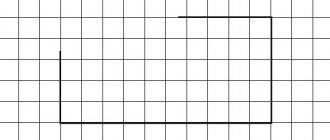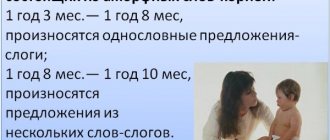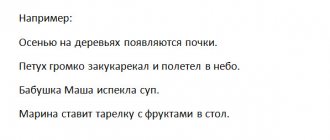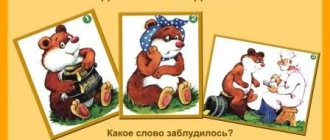Diagnostics of speech development of children 2-4 years old.
Formation of a dictionary.
To conduct a diagnostic examination of younger preschoolers and identify their level of speech development, illustrative material is needed: thematic subject and plot pictures. Children need to be interested, and therefore all tasks are offered in a playful way.
Preschoolers should navigate the following lexical topics: “Seasons”, “Toys”, “Vegetables and fruits”, “Clothing and footwear”, “Dishes”, “Furniture”, “Personal hygiene items”, “Domestic and wild animals”, “Poultry”, “Insects”, “Man. Body parts".
To reinforce nouns, you can offer task options.
- Option. 1. In the table of different object pictures, the adult shows any image, and the child must say what it is.
- Option 2. An adult names an object, and the child must find its image.
- Option 3. An adult offers to select all the pictures on a given topic. For example, “Show me the toys.” "Get your vegetables." “Where are the pets?”
The use of verbs in speech can be checked by offering a preschooler of this age story pictures depicting work actions, methods of transportation, and emotional states of people. The child, looking at the picture, must answer the questions asked. For example, “How does a worm move? Butterfly?" etc.
You can suggest the game “Who gives what voice?” – the adult asks “How does the rooster crow? Duck? Sparrow? Cat? etc.
Adjectives. An adult shows either a picture or some object and asks to determine its color, size, and what it tastes like. For example, lemon (yellow, sour).
For preschoolers 3-4 years old, offer the game “Say it the other way around.” The adult begins the phrase, and the child finishes:
- The elephant is big, and the mouse... (small).
- Mom has long hair, and dad... (short).
- The wolf is brave, and the hare... (cowardly).
To check the adverbs (high-low, far-close, warm-cold), you will also need plot pictures.
Grammatical structure of speech
To test children’s ability to put nouns into the plural form, he is asked to look at paired object pictures (chair-chairs, plate-plates, etc.) and answer “What is shown in one picture? (one subject) to another? (several items).
Testing the development of skills to form diminutive forms of nouns occurs with the help of subject pictures. The child can be asked to name the depicted objects affectionately, for example, doll - doll, table - table, apple - apple, etc.
The ability to coordinate nouns and pronouns with verbs is better with the help of story pictures or toys and leading questions. For example, a doll sleeps, but what about dolls? The ball lies, but what about the balls?
The use of verbs in different tenses can be reinforced with questions like, “What are you doing now? What did mom do yesterday? What are you doing tomorrow?"
The correct use of prepositions is also checked using questions about plot pictures or the location of objects in space. For example, there is a box in front of the baby, there is a red cube in it, and a green one on it, a doll is sitting in front of the box, and a matryoshka doll is behind it. You can ask the child questions: “Where is the doll? Cubes? Green cube? Red? etc.
Sound culture of speech
This is a clear pronunciation of all sounds. An adult can hear mistakes in the everyday speech of preschoolers. You can also ask the child to repeat words after the parent to check a specific sound, for example, the hard and soft sound “m” - mouse, ball, Masha, bear.
Connected speech
Preschoolers should be able to:
- express your thoughts clearly;
- tell a familiar fairy tale, an event from your life (How did you spend your weekend? What did you like about the circus? etc.;
- compose a short descriptive story about a toy using leading questions and based on the plot picture “The doll is having lunch,” “The boy is playing with toys.”
The table shows approximate requirements for telling a familiar fairy tale (for a high level of speech development in younger preschoolers).
| 2-3 years | 3-4 years |
|
|
LiveInternetLiveInternet
Quote from Hugo_Pugo_handicrafts message
Read in full In your quotation book or community!
TEST.
METHODOLOGY FOR SPEECH DEVELOPMENT. CONTINUED 21. Considers prefixes and suffixes -….
- A) all answers are correct; B) there is no correct answer; B) word formation; D) inflection; D) coordination; E) syntax;
22. Forms of work on the formation of the grammatical structure of speech -.
- A) all answers are correct; B) there is no correct answer; B) specially organized classes; D) classes on speech development from other sections (for example: ZKR, dictionary, etc.); D) didactic games and exercises;
23. The pronunciation of preschool children is normalized by ... years.
- A) all answers are correct; B) there is no correct answer; AT 4; D) 5; D) 6; E) 7;
24. The ability for phonemic analysis appears in children by ... years.
- A) all answers are correct; B) there is no correct answer; AT 4; D) 5; D) 6; E) 7;
25. How many stages of work on sound are envisaged as part of the formation of the ZKR?
- A) all answers are correct; B) there is no correct answer; AT 4; D) 5; D) 6; E) 7;
26. How many areas of work are provided at the preparatory stage of work on the formation of the ZKR.
- A) all answers are correct; B) there is no correct answer; AT 4; D) 5; D) 6; E) 7;
27. Which of the listed tasks are solved as part of the final lesson on ZKR.
- A) all answers are correct; B) there is no correct answer; C) development of fine motor skills; D) training pronunciation skills; D) development of breathing characteristics; E) sound call; G) improving the ability to distinguish a given sound in someone else’s and one’s own speech.
28. Which of the tasks of speech development includes working on stress?
- A) all answers are correct; B) there is no correct answer; B) vocabulary work; D) sound culture of speech; D) grammatical structure of speech; E) coherent speech; G) familiarization with fiction; H) preparation for literacy training.
29. Which of the listed areas of educational work is influenced by speech development?
- A) all answers are correct; B) there is no correct answer; B) mental; D) sensory; D) aesthetic; E) moral; G) physical; H) labor.
30. Which of the listed tasks is the culminating one (not in sequence, but in logic) in the work of a preschool educational institution on speech development and is based on all other tasks (areas of work)
- A) all answers are correct; B) there is no correct answer; B) vocabulary work; D) sound culture of speech; D) grammatical structure of speech; E) coherent speech; G) familiarization with fiction; H) preparation for literacy training.
31. The ability to use prefixes as part of the work on the formation of GSR refers to ....
- A) all answers are correct; B) there is no correct answer; B) word formation; D) inflection; D) syntax;
32. The ability to use prepositions as part of the work on the formation of GSR refers to ....
- A) all answers are correct; B) there is no correct answer; B) word formation; D) inflection; D) syntax;
33. How often are special frontal classes on the formation of GSR conducted?
- A) all answers are correct; B) there is no correct answer; B) once a month; D) 2 times a month; D) 3 times a month;
34. The main function of coherent speech.
- A) all answers are correct; B) there is no correct answer; B) communicative; D) nominative; D) regulating.
35. Speech associated with a specific, visual situation, understandable only in this specific situation.
- A) Contextual; B) situational;
36. “It’s Tanya’s birthday. We need to congratulate her, how do we do this?” - what is this technique for developing coherent speech called?
- A) all answers are correct; B) there is no correct answer; B) conversation; D) conversation; D) verbal instruction; E) search questions;
37. What is the difference between conversation and conversation.
- A) all answers are correct; B) there is no correct answer; B) topic; D) duration of the event; D) tasks to be solved; E) preliminary preparation; G) the material used.
38. “What color is the snow?” is a question of... character.
- A) all answers are correct; B) there is no correct answer; B) reproductive; D) search; D) problematic;
39. The structure of which lesson is most similar to the structure of the retelling lesson.
- A) all answers are correct; B) there is no correct answer; B) looking at pictures; D) writing a descriptive story; D) memorization; E) reading works of fiction.
40. Which of the listed activities belong to the section “Vocabulary work”.
- A) all answers are correct; B) there is no correct answer; B) looking at pictures; D) writing a descriptive story; D) memorization; E) reading works of art, G) excursions; H) Looking at toys.
41. In the “Preparing Children for Literacy” section, the “Broken Phone” game is usually used to introduce children to the concept of ... .
- A) all answers are correct; B) there is no correct answer; B) sound; D) syllable; D) stress; E) word; G) proposal; H) text.
42. Which of the following concepts cannot be practiced using the “Sound Clock” manual?
- A) all answers are correct; B) there is no correct answer; B) sound; D) syllable; D) stress; E) word; G) proposal; H) text.
43. How often is it recommended to read works of fiction to children?
- A) all answers are correct; B) there is no correct answer; B) 5 times a week; D) 4 times a week; D) 3 times a week; E) 2 times a week; G) once a week;
44. At what age group do we begin to actively involve the child in repairing books when working in the book corner?
- A) all answers are correct; B) there is no correct answer; B) younger; D) average; D) eldest; E) preparatory;
45. When a teacher invites a child to place his hand on his neck when pronouncing a sound, he wants to demonstrate that this sound is ....
- A) all answers are correct; B) there is no correct answer; B) vowel; D) consonant; D) hard; E) soft; G) voiced; H) deaf; I) nasal; K) oral.
Until I bought myself a home water filter, I’m ordering water delivery to my home, but it’s a useful thing... And if you turn here: “Water Delivery”, then not only will they deliver water to you, but also tea, coffee, disposable tableware, and even the cooler will be serviced...









